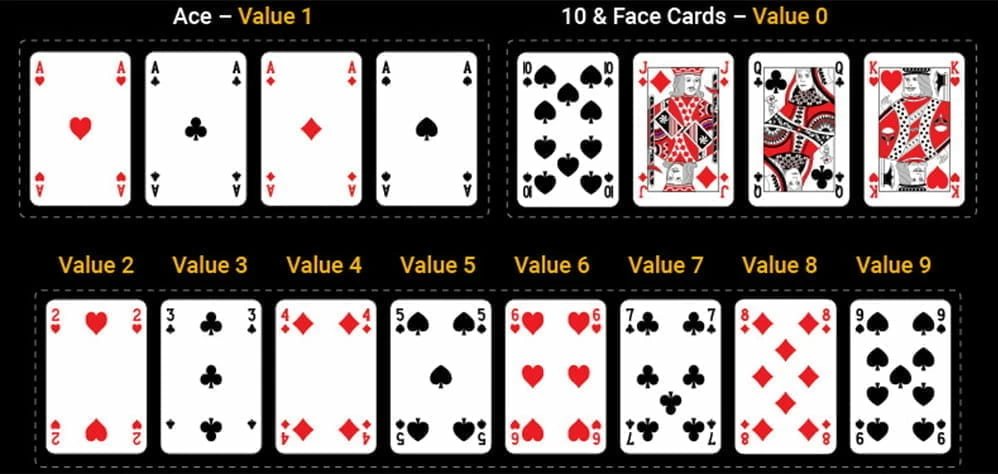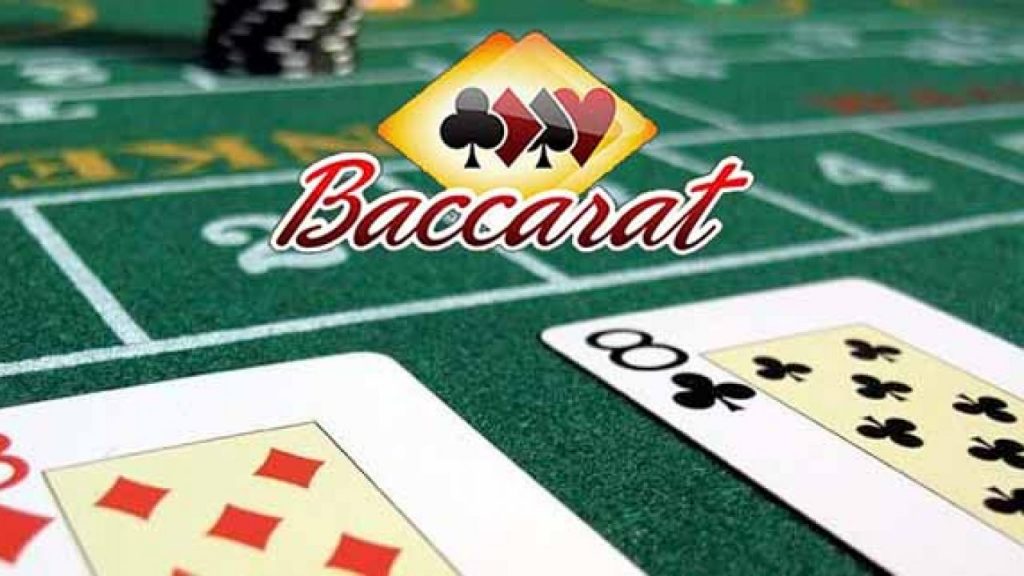How to Beat Baccarat with Card Counting: Baccarat Card Counting Systems
Counting cards in baccarat can be considered a controversial subject. While many are familiar with blackjack card counting, the idea of baccarat card counting is less well-known. To help you understand the ins and outs, we’ve broken down how card counting works, if it’s even viable in baccarat, and some key strategies if you choose to pursue this approach.
Card Values and Dealing Process
In the classic game of baccarat, the dealing process begins with the player and the banker each receiving two cards, often from a shoe containing multiple decks. In the sequence of how baccarat is dealt, the player’s first two cards are given out before the banker’s. The card dealt could hold varying values: face cards and tens have a value of zero, aces are valued at one, and every odd card from two through nine retains its face value. When determining the value of baccarat hands, you sum the values of each given card in the hand, but only the last digit of the total counts. So a hand with a total of 12 is considered a 2. In the context of methods to count cards, players would track the ratio of high to low-value cards remaining in the deck, though the effectiveness of this strategy in baccarat is debated. Note that in baccarat, unlike poker, the card backs do not carry any significance as all cards are dealt face-up. Hence, understanding how cards are dealt and their values is a vital part of mastering the game, whether you’re applying advanced strategies or simply enjoying the game’s flow.
- Mostbet Casino offers a vast array of games, including slots, table games, live casino, sports betting, and esports, ensuring a diverse and engaging gaming experience.
- Mostbet Casino is optimized for mobile devices, allowing players to enjoy their favorite games on smartphones and tablets.
- For sports enthusiasts, Mostbet Casino provides competitive odds and a wide range of betting options, enhancing the excitement of sports betting.
- Pin Up Casino offers a diverse range of games, including slots, table games, live casino, jackpot games, and tournaments, providing ample entertainment options for players.
- The casino provides enticing bonuses, such as welcome bonuses and free spins, allowing players to boost their bankroll and enhance their gaming experience.
- Pin Up Casino supports various currencies, including CAD, USD, EUR, and RUB, accommodating players from different regions.
- Wide selection of games, including Baccarat
- Generous bonuses and promotions
- Mobile app available for download
- User-friendly platform
- Secure and safe gaming environment
The Basics of Card Counting
Counting cards involves tracking cards from the beginning of the game and making educated guesses about the cards left in the deck. Card counters keep a mental tally of specific card values as they’re dealt. In games like blackjack, where the house edge is smaller, card counting can give players an advantage. However, with regards to baccarat, it’s a different story.
Card Counting in Baccarat vs Blackjack Card Counting
Are you wondering about card counting in blackjack and baccarat? At Baccarat-Tips, we explore the possibility of a casino reshuffling the deck before it reaches the cut card, as well as if there are better returns on your money through card counting in baccarat. If you have further queries, comments, or ideas, drop us an email!
In comparison to baccarat, blackjack is a game where card counting can provide a significant edge. This is because the player’s strategy can change based on the cards that have been dealt, meaning the odds can shift from the house to the player. However, baccarat is not a countable card game in the same way. The rules and the house edge in baccarat make card counting less effective. Regardless, some players attempt to count cards in baccarat using unique strategies.

Shuffling between rounds can be tiring for non-card counting players since it gives them the opportunity to leave the table. Furthermore, those who are short on time will not have as much control over the number of hands they can play, resulting in reduced revenue for casinos from these recreational players.
Baccarat is a game in which cards are dealt and then placed in a discard rack. They will not reappear until after the next shuffle. It is possible to use a card counting system by keeping track of the remaining cards, but this would require a lot of mental effort for only a small chance of winning. The house edge in this game is already quite low, at 1.17 percent if playing the bank bet and 1.36 percent if playing the player bet. However, even if using a perfect system, the best minds in card counting have estimated that you would only earn less than ten cents per day from playing baccarat – not worth the effort.
How Does Baccarat Card Counting Work?
If you’re familiar with baccarat, then you know that there are three bets available – banker hand, player hand and both hands tying. Of the three, basic strategy dictates that the banker wager is best; despite a 5% house commission on all winning bets here, it still holds only a 1.06% edge over the player! However if you should ever tire of the banked bet altogether, then consider sticking to a player bet: though its house advantage stands at 1.24%, this can prove an acceptable proposition for some players too
Placing a tie bet comes with an unfavorable 14.36% house edge when 8:1 payouts are given, yet this number drops to 4.85% if you leverage the 9:1 returns for profitable wagers. In line with fundamental strategy, both banker and player hands are your best options in baccarat- especially if counting cards is involved too! Since then, it’s just a matter of ascertaining which hand has the better likelihood of success overall.
Before you start card counting, the first step is to find a gaming table with an untouched 6 or 8-deck shoe. This gives you the opportunity to track cards from their initial appearance and make informed decisions about whether you should bet on the banker or player side.

The Baccarat Card Counting System: Ways to Beat Baccarat
In a baccarat card counting system, players track the ratio of cards left in the deck to determine if it’s better to bet on the banker or the player. The counting system work is based on the card values: low cards are good for the player bet while high value cards favor the banker bet. In this sense, card counting in baccarat can assist with determining when to place the banker bet or when to bet on the player position. However, the effectiveness of this baccarat card counting strategy to become effective is debatable.
Card Counting The Dragon 7 and EZ Baccarat
A key aspect to discuss when talking about baccarat card counting is the Dragon 7 side bet in EZ Baccarat. This variant of baccarat differs from traditional baccarat games by removing the commission on the banker bet and changing the rules to make the Dragon 7 bet profitable. The Dragon 7 is a specific bet that the banker hand wins with three cards and a total score of seven. Counting the Dragon 7 involves tracking the remaining odd cards to assess the likelihood of this outcome.
- Bitstarz Casino is known for its cryptocurrency support, particularly Bitcoin, allowing players to enjoy the benefits of fast, secure, and anonymous transactions.
- The casino offers a vast array of games, including slots, table games, live dealer games, and more, with options from top-notch software providers.
- Bitstarz offers an immersive live casino experience, featuring real-time interaction with professional dealers and a wide range of live games to choose from.
- 1xSlots Casino offers an extensive library of games, including slots, table games, live dealer games, and more, with options from numerous reputable software providers.
- The casino embraces cryptocurrencies, allowing players to make transactions using popular digital currencies like Bitcoin, Ethereum, and Litecoin, offering enhanced security and anonymity.
- 1xSlots provides a generous welcome bonus package for new players, often including a combination of bonus funds and free spins to boost their initial gaming experience.
- Vast selection of games from multiple top providers.
- User-friendly interface and intuitive navigation.
- Supports various reliable payment methods, including cryptocurrencies.
- Strong emphasis on responsible gambling.
- The casino offers a diverse selection of games, including slots, table games, live dealer games, and more, with options to suit all types of players.
- 888casino provides a high-quality live casino experience, with professional dealers, real-time interaction, and a variety of live games to choose from.
- 888casino offers a range of enticing bonuses and promotions, including a generous welcome bonus for new players, ongoing promotions, and a loyalty program.
Advantages of Baccarat Card Counting
Baccarat counting is a strategy used by some players to try and gain an advantage over the casino. Here are some potential advantages of card counting:
- Increased knowledge of the deck: By keeping track of which cards have been played, a player can gain a better understanding of which cards are left in the deck. This can help them make better decisions about whether to bet on the player or banker hand.
- Better betting decisions: With a better understanding of the remaining cards, a player can make more informed decisions about how much to bet and when to bet. This can help them manage their bankroll more effectively and potentially increase their winnings.
- Higher win rate: By using a card counting strategy, a player can increase their chances of winning each hand. While it doesn’t guarantee a win, it can tilt the odds in the player’s favor.
- Reduced house edge: Baccarat already has a relatively low house edge compared to other casino games, but by using a card counting strategy, a player can reduce the house edge even further.
It’s important to note that baccarat card counting is not foolproof and requires a significant amount of skill and practice. Additionally, casinos are aware of this strategy and may take measures to prevent players from using it, such as shuffling the deck more frequently or limiting the number of hands a player can bet on.
Count Cards in Baccarat with Mobile App
In today’s digital age, several apps offer features designed to aid in the card counting process, for both baccarat and blackjack. One such tool is a card counting application with a built-in calculator. This app simplifies the card counting approach by tracking the ratio of high to low-value cards left to get in the deck. Players can input the dealt cards, and the app will compute and update the count based on the best card counting strategies. Furthermore, it can help track the odd cards remaining, a significant factor in certain baccarat strategies. Despite the controversies surrounding their effectiveness, these apps offer a novel and exciting way to engage with these classic casino games, particularly for those keen on exploring card counting methodologies.
Does counting cards help in baccarat?
Whether or not card-counting in baccarat is a worthwhile pursuit is entirely up to personal preference. While some players may consider it an enjoyable way of making money while playing their favorite game, Baccarat-Tips team personally cannot fathom devoting so much time and effort into something that yields such meager results. Waiting hundreds of hands before you can place your bet on the ideal probability doesn’t appeal to me either. It’s likely that the casino will eventually call you out if they catch wind of your lingering at baccarat tables for extended periods, as casinos don’t want patrons to stay stagnant when only a few wagers are being placed.
Conclusion: Can You Beat Baccarat with Card Counting?
Counting cards in baccarat is possible, but not as straightforward or as profitable as counting cards in blackjack. If you want to bet and enjoy baccarat, stick to basic baccarat strategy rather than counting cards. Your focus should be on enjoying the casino game, whether you’re playing baccarat or blackjack, rather than looking for ways to beat the system with card counting. After all, baccarat is a game of luck and chance, much like every other casino game.
FAQ
-
What advantages does counting offer?
Counting offers a slightly advantages for players. It helps players gain an increased knowledge of the deck by tracking which cards have been played and which ones remain in the deck. This can help them make better decisions when it comes to betting on either the banker or player hand.
-
How can a player reduce the house edge using counting?
By using counting, players can reduce the house edge by predicting the relative amounts of high and low cards that remain in the deck.
-
Is it possible to make money from baccarat card counting?
It is theoretically possible to make money from card counting, but it is highly unlikely. While card counting can give players an edge over the house in theory, the small house edge of baccarat means that these profits are often negligible. Furthermore, casinos are aware of card counting strategies and may employ extra security.
-
Does counting cards in Baccarat help increase your win rate?
While it’s not foolproof, it can give players an increased knowledge of the deck and potentially help them increase their win rate. By tracking which cards have been played and which remain in the deck, players can make better decisions when betting on either the banker or player hand.
-
How many decks should be used for successful Baccarat Card Counting?
Successful card counting requires the use of multiple decks to be effective. Generally, it is recommended to use at least six decks. This may be increased to eight depending on the number of players at the table and the level of play they are engaging in.
-
Are there any specific strategies to use when practicing Card Counting?
When practicing card counting, the most important thing is to know the different strategies that can be used when making bets. One of the most popular strategies is called “Back-Counting”, where players base their bet on the total amount of high and low cards that remain in the deck. By tracking which cards have been played and which remain in the deck, players can make better decisions when betting on either the banker or player hand.







